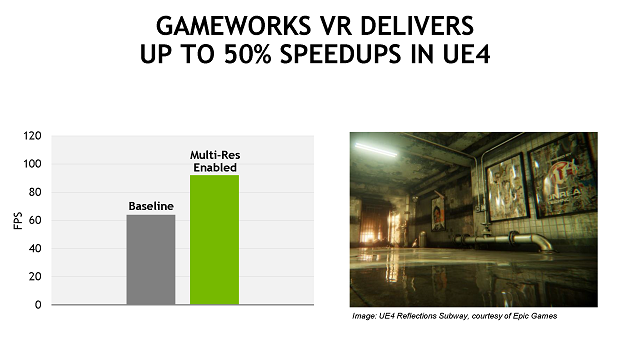NVIDIA the computing company that creates the GeForce range of graphics cards, announced earlier this week that one of the features of its GameWorks VR toolset, Multi-res Shading, will be added into Unreal Engine 4 itself ‘in the next few updates’. Now the company has revealed further details of the benefits the Gameworks VR integration will produce.
Multi-res shading works with virtual reality (VR) headsets to put more performance where users will see it. Delivering higher resolution at the centre of the image, where eyes are focused, and lower resolution at the periphery, where they’re not.
NVIDIA states on its blog: “Because VR headsets “warp” or distort the periphery of an image, Multi-res Shading saves graphics workload without sacrificing image quality. “This GameWorks VR technology will help VR developers get up to 50% more performance out of their UE4-based VR games and applications.
The main components of GameWorks VR for game and application developers are:
- VR SLI, provides increased performance for virtual reality apps where multiple GPUs can be assigned a specific eye to dramatically accelerate stereo rendering. With the GPU affinity API, VR SLI allows scaling for systems with >2 GPUs.
- Multi-Res Shading, an innovative new rendering technique for VR whereby each part of an image is rendered at a resolution that better matches the pixel density of the warped image. Multi-Res Shading uses Maxwell’s multi-projection architecture to render multiple scaled viewports in a single pass, delivering substantial performance improvements.
And for headset developers:
- Context Priority, provides headset developers with control over GPU scheduling to support advanced virtual reality features such as asynchronous time warp, which cuts latency and quickly adjusts images as gamers move their heads, without the need to re-render a new frame.
- Direct Mode, the NVIDIA driver treats VR headsets as head mounted displays accessible only to VR applications, rather than a typical Windows monitor that your PC shows up on, providing better plug and play support and compatibility for VR headsets.
- Front Buffer Render_–enables the GPU to render directly to the front buffer to reduce latency.
VRFocus will continue to report on the latest details of Gameworks VR integration into Unreal Engine as they’re announced.
-END-
The post Gameworks VR Multi-Res Shading Could Deliver 50% more performance For Unreal Engine appeared first on VRFocus.















